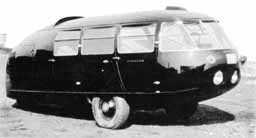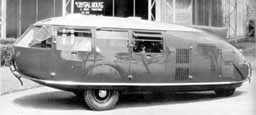Dymaxion car chronology
< back up to dymaxion car notes
- 1927
- late in 1927, Bucky turns his attention to the transport phase of his
comprehensive plan
- he invents, at least on paper, his "4D twin, angularly-orientable, individually
throtleable, jet-stilt, controlled-plummeting transport"
- 1933
- given as main date for the car
- January 1933, a friend gives "a few thousand dollars" for Bucky to test
some of his Dymaxion ideas
- due to the Depression at the time, this money has very large buying
power
- Bucky knows the Dymaxion house was not yet affordable to develop, and
that jets weren't yet feasible, so he decides to focus on a ground vehicle
- March 1933, rents a disused factory in Bridgeport, Conn.
- screens 1,000 job applicants, hires crew of 27 to work under the engineering
direction of Starling Burgess
- July 12, 1933, demonstrated to the public
- front-wheel drive, rear engine and rear-wheel steering
- aluminum body, chrome-molybdenum aircraft steel chassis
- 1/8th inch shatterproof glass
- 19.5 feet long
- about a half-ton
- a great deal of suspension: The first frame, hinge-supported by
the front wheels, carried the engine and drive shaft. Frame No.
2 was hinge-and-spring connected to Frame No. 1, but was supported by
the steerable tail wheel. The body, in turn, had its own independent
frame which was sprung directly from the front axle, with a balancing
spring connected back, abreast the engine, to Frame No. 1. The
consequence [...] was that the car could zoom across open fields with
the agility of a light plane, yet provide a ride as smooth as any cruise
on a highway.
- Car #1

- color: white, with dark belly
- sold to Captain "Al" (Alford F.) Williams, then holder of the world's
speed record for seaplanes
- Col. William Francis Forbes-Sempill, an English aviation expert,
commissioned to come to the US and test the performance of car
No. 1
- car is involved in fatal accident (what date?)
- both Williams and Fuller, after carefully inspecting the car's functioning
parts and reconstructing the sequence of events, were convinced that
the Dymaxion car itself had no design or structural fault which had
a bearing on the accident
- car is repaired
- Williams sells it to the director of the automotive division of
the U.S. Bureau of Standards
- another source [3] says it was sold to Gulf Oil
- was very lightwight, weighing about as much as a VW beetle [3]
- October 18, 1933: US Patent application is submitted
- 1934
- Car #2

- second car built on order from a group of English automobile enthusiasts
- completed in January 1934
- flat window panels on the front, instead of the rounded glass
on Car #1
- improved, lighter frame structure
- color: entirely dark, and shiny
- they no longer wanted it due to the bad publicity of Car #1's crash
- some time later, Fuller sells it to a group of his Bridgeport mechanics
- years later, it ended up USED AS A CHICKEN COOP [3]
- also fairly light, but a little heavier than the first one [3]
- Car #3

- Fuller spends his "entire family inheritance" to built car #3
- color: emerald green, with white top and a blue Formica interior.
[3]
- according to J. Baldwin, it was really heavy, "built like a tank"
- completed in 1934, makes it to the Chicago World's Fair
- sold to Leopold Stokowski and his wife,
who sold it a few months later
- during the next nine years the car is resold many times, and for
a long span disappears from sight
- Peter Viemeister relates a story of
going for a ride in the car in 1934, when he was not yet 6 years old.
1937
- December 7 1937: US Patent Office grants
the car patent #2,101,057
- 1943
- Car #1 is destroyed in a fire in the U.S. Bureau of Standards' Washington
garage
- at the request of Henry Kaiser, Bucky redesigns the car, making use
of newer automotive technology
- the new design which was never built:
- Powered by three separate air-cooled "outboard" type (opposed cylinder)
engines, each coupled to its own wheel by a variable fluid drive.
Each of the engine-drivewheel assemblies was detachable. The engines themselves were run always at the same speed; the speed
of the car was controlled by varying the quantity of fluid in the coupling.
- Low-horsepower engines - 15 to 25 hp, cut down to one engine at
cruising speed, for 40-50 mpg
- Steered at cruising speeds by the front wheels, rear-wheel steering was used only as an auxiliary for tight turns,
or to move sideways
- Tail mounted on extensible boom
- summarized by J. Baldwin: "Ten years later, Bucky put what he'd learned
to work in a much handier five-seater with a tiny engine at each wheel.
This time, the front wheels steered, but all three could be steered for
tight city turns and crabbing sideways into parking spaces. High speed stability
was enhanced by extending the rear wheel on a boom to lengthen the wheelbase."
- 1944
- Car#3 is discovered in Brooklyn, and repurchased for Fuller by his friend,
J. Arch Butts, Jr. of Wichita, Kansas
- 1945
- Car#3 shown at Wichita airport
- estimated to have been driven 300,000 miles
- Fuller restores it to prime condition
- 1950s
- Car#3 disappears. J. Baldwin says he finally tracked down a junkyard
owner in Wichita who says he cut it up for scrap during the Korean war.
[3]
- 1960s
- Reportedly, the magazine "Car and Driver" did some articles on the Dymaxion
car in the late 60s.
- Reportedly: "I remember the car being on display in the basement of
the Museum of Science and Industry in Chicago in the mid 60's. I was
frustrated because the windows had been painted and I couldn't see
inside."
- 1970
- 1970s
- Reportedly, a wealthy patron from Beatrice,
NE puts up the money to build three Dymaxion cars. This results in
3 chasses and 2 fiberglass bodies, but no finished vehicle.
- Some people recall seeing a Dymaxion (presumably Car #2) listed for
sale in Hemming Motor News in the mid-to-late 70s, with "the owner not
asking a lot of money for it (under ten grand) ... the ad was in the
front of the magazine in the special auto section"
- Ted Staub reports "My Dad owned one of the
Dymaxion cars ... 1978-1980 time frame.. in Kettering, OH"
- 1981
- Bucky and his car pose with his 26' Fly's Eye dome during his 85th birthday
party at the Windstar Foundation in Snowmass, Colorado
- 1995
- July 1995, GENI sponsors and organizes
the Buckminster Fuller Symposium and Centennial Celebration for 600 participants.
Activities included a multi-media Opening Ceremony, several World Games,
Symposia by 15 colleagues and students of Bucky, a Film Festival,
display of the only remaining Dymaxion Car, and a Bucky
for Kids Festival."
- 1998
- 2009
Some resources used for this chronology:
- [1] Dymaxion Transport
page by J. Baldwin
- [2] The Dymaxion World of Buckminster Fuller, Robert W. Marks (1960,
1973)
- [3] correspondence between Wallace Johnston
and Ann Willmott Andersson at WNET, which has some known inaccuracies in it


